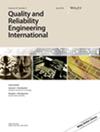Comparing the performance of the Cpk and (X‐bar, S) sampling plans
IF 2.2
3区 工程技术
Q3 ENGINEERING, INDUSTRIAL
引用次数: 0
Abstract
When the Cpk sampling plan is in use, a sample of size (n) is taken from the lot, and the mean and the standard deviation of the sample observations are used to obtain the —the sample estimator of the Cpk index; if the is lower than a threshold (c0), then the lot is rejected, otherwise, the lot is accepted. In recent studies, the α and β risks are the risks of rejecting/accepting lots of items produced by in‐control/out‐of‐control processes with Cpks equal to (, that is, the two parameters (n, c0) of the Cpk sampling plans depend on the inputs (α, , βmax¸ ). When the design of the Cpk sampling plan is based on the inputs C0 and C1, the optimum sample size is always big and, excluding the cases where the magnitude of the mean shift is too small, the β risks associated to the combinations of mean shifts and variance increases (determined by the inputs C0 and C1) are always equal to the maximum allowed value βmax. This fact motivated us to compare the Cpk sampling plan with the (X‐bar, S) sampling plan, where the sample mean (X‐bar) and the sample standard deviation (S) are directly compared with thresholds. For most disturbances, the (X‐bar, S) sampling plan requires smaller samples to meet the condition of β ≤ βmax, that is, for a fixed sample size, it is always possible to find endless combinations of mean shifts and variance increases where the β risks of the (X‐bar, S) sampling plan are β = βmax, and the β risks of the Cpk sampling plan are β > βmax.比较 Cpk 和 (X-bar, S) 采样计划的性能
使用 Cpk 抽样计划时,从批次中抽取一定大小(n)的样本,利用样本观测值的平均值和标准差得到 Cpk 指数的样本估计值;如果该估计值低于阈值(c0),则剔除该批次,否则接受该批次。在最近的研究中,α 和 β 风险是指在 Cpks 等于()的情况下,拒绝/接受由控制内/控制外过程生产的物品批次的风险,即 Cpk 抽样计划的两个参数(n、c0)取决于输入(α, , βmax¸ )。当 Cpk 抽样计划的设计基于输入 C0 和 C1 时,最佳样本量总是很大,而且除去均值偏移量太小的情况,与均值偏移和方差增加(由输入 C0 和 C1 决定)组合相关的 β 风险总是等于允许的最大值 βmax。这一事实促使我们将 Cpk 采样计划与 (X-bar, S) 采样计划进行比较,在后者中,样本平均值 (X-bar) 和样本标准偏差 (S) 直接与阈值进行比较。对于大多数干扰,(X-bar,S)采样方案需要较小的样本量才能满足 β≤ βmax 的条件,也就是说,在样本量固定的情况下,总能找到均值移动和方差增大的无穷组合,此时(X-bar,S)采样方案的 β 风险为 β = βmax,而 Cpk 采样方案的 β 风险为 β > βmax。
本文章由计算机程序翻译,如有差异,请以英文原文为准。
求助全文
约1分钟内获得全文
求助全文
来源期刊
CiteScore
4.90
自引率
21.70%
发文量
181
审稿时长
6 months
期刊介绍:
Quality and Reliability Engineering International is a journal devoted to practical engineering aspects of quality and reliability. A refereed technical journal published eight times per year, it covers the development and practical application of existing theoretical methods, research and industrial practices. Articles in the journal will be concerned with case studies, tutorial-type reviews and also with applications of new or well-known theory to the solution of actual quality and reliability problems in engineering.
Papers describing the use of mathematical and statistical tools to solve real life industrial problems are encouraged, provided that the emphasis is placed on practical applications and demonstrated case studies.
The scope of the journal is intended to include components, physics of failure, equipment and systems from the fields of electronic, electrical, mechanical and systems engineering. The areas of communications, aerospace, automotive, railways, shipboard equipment, control engineering and consumer products are all covered by the journal.
Quality and reliability of hardware as well as software are covered. Papers on software engineering and its impact on product quality and reliability are encouraged. The journal will also cover the management of quality and reliability in the engineering industry.
Special issues on a variety of key topics are published every year and contribute to the enhancement of Quality and Reliability Engineering International as a major reference in its field.

 求助内容:
求助内容: 应助结果提醒方式:
应助结果提醒方式:


